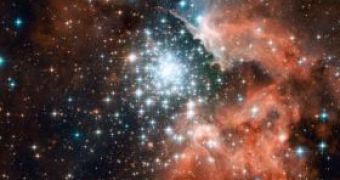Hubble has been observing one of the most investigated space locations for star genesis, the gigantic nebula NGC 3603, harboring one of the largest young clusters in the Milky Way. NGC 3603 is located in the Carina spiral arm of the Milky Way, around 20,000 light-years from the Sun System.
Hubble Space Telescope sent images of a young star cluster wrapped in a large area of dust and gas, the majority of the bright stars being the hot, blue type. They generate UV radiation and violent winds that have induced a huge cavity in the gas and dust cover of the cluster.
The young cluster contains stars of various sizes, but similar ages. Stars of different sizes change at a different rhythm and thus complete studies of several star types at various stages in their lives are possible. By comparing clusters of various ages, it could be seen how their traits (like temperature and brightness) shift with the age.
"The cluster appears to gather the most massive stars at its core." said lead researcher Dr Jes■s Ma?z Apell?niz from Instituto de Astrof?sica de Andaluc?a, Spain.
The team has found that the distribution of various types of stars at the core of this dense cluster matches that of other young clusters in the Milky Way. 3 brightest stars in the middle seem much bigger than theoretically possible. The "heavyweights" could be two or more huge stars whose lights appear like one, but Hubble's resolution cannot separate each star in the three gatherings.
This matches the recent finding made by Dr. Anthony Moffat from the Universit? de Montr?al, Canada, employing ESO's Very Large Telescope (VLT) and Hubble's Near Infrared Camera and Multi-Object Spectrograph (NICMOS), who calculated the movements of the individual stars in 2 of the 3 "heavyweights". The mass of the biggest star could oversize 115 times that of the Sun, being compatible with the acceptable theoretical conventions.
NGC 3603 has about 400 000 solar masses of gas and a few Bok globules, dense dark dust and gas clouds, whose masses oversize 10 to 50 times the Sun. They look like insect cocoons and are collapsing under their own weight, generating new stars. These objects could be amongst the coldest in the Universe.
This nebula also contains a blue supergiant star, Sher 25, which soon could turn into a supernova.

 14 DAY TRIAL //
14 DAY TRIAL //